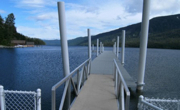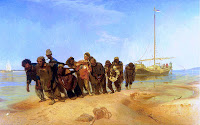This article was originally published on ClubOrlov.com
Well, such boats were quite usual before, and I think that they will be usual once more. Their advantages are just too numerous. To start with, square, flat-bottom boats go aground really well. The typical yachty/boaty person would inevitably inquire, “How well does it go to windward?” (windward ability being the sine qua non of any self-respecting windship in spite of the fact that the entire planet was explored and colonized by windships that could do no better than 60º to windward). As a matter of fact, Hogfish goes to windward very well. But there is a far more important question to ask: “How well does it go aground?” The typical keelboat-runs-aground scenario goes like this. Keelboat sails along, heeled over, and the keel scrapes the bottom. This causes the boat to slow down and as it does so it heels less, causing the keel to dig in even deeper, and get stuck. The boat is then at the mercy of the tides, and if the tide goes out, then the boat flops over on its side and bangs around in the surf. This is unsafe, uncomfortable and unnecessary. On the other hand, the typical square boat, be it a sharpy or a sailing barge/scow, with its perfectly flat bottom, sails along, heeled, over, and its centerboard scrapes the bottom. This causes the centerboard to bounce up, ideally waking up the skipper, who then does something to avoid running aground. But if the skipper remains fast asleep and the boat does run aground, the part of it that hits first is the chine—the corner between the bottom and one of the topsides. This causes the boat to slow down, and as it does so it heels less, causing it to draw less water, and hence to free up and continue floating. If the skipper continues to doze, or simply doesn't care, it will eventually run aground, rocking to and fro like a gigantic rocking chair. When the tide goes out, it will continue to simply sit there, and when the tide comes back in, it will float off again. If waves push it onto the beach, it can still be refloated later by rolling it over logs. And so it stands to reason that if what you have is a keelboat, then you really don't want to ever run aground, because if you do, it's likely to end badly for you and the boat. Whereas if you are in a square boat, then, why the heck not? You might even do it on purpose—to scrape the seafood off the bottom, and, if you time the tides just right, maybe even to paint it; or just to get a good night's sleep without all the incessant rocking; or maybe you are keen on making some astronomical observations and need a stable platform on which to mount your telescope; or maybe you have some goods to load or unload off a beach, and want porters to be able walk right up to your boat at low tide; or maybe your boat is a floating clinic and you don't want it to move while you are performing an appendectomy or a root canal. You see, the reasons for wanting to run aground are virtually endless, and being able to do so with relative impunity is a major advantage, while, on the other hand, at any given time any given boatyard is likely to have a few keel boats in it that have run aground, and aren't in good shape as a result: destroyed rudders, bent rudder posts, sprung keel bolts and holed topsides are not uncommon. In addition to shoal draft (not needing much water to float) and the ability to go aground in safety, comfort and style, square boats are also quite cheap to build. A square boat can be made out of five pieces of flat stock (plywood, sheet metal, etc.) joined along the edges: bottom, two sides, transom and deck. Boats of this type used to be built all up and down the East Coast, by the people who sailed them. A fisherman and his son would spend maybe a week knocking one together right on the beach, then launch it and go fishing. Ceres, which is a fairly serious cargo craft, not a fishing smack, seems pretty far along after less than 200 person-hours of work. And yet square boats are a rarity. There are several Philip Bolger sharpie designs around. There is Matt Leyden's “Paradox,” which is a tiny, trailerable yet ocean-capable cruising boat that has a bit of a cult following, and there are many specimens of it floating about. There is Chris Morejohn's “Hogfish” and “Hogfish Maximus,” plus one more, called “Jubilee,” exactly one of each is in existence. There is Dave Zeiger, who has been cruising Alaska in a “Triloboat,” sailing scow. If I am missing someone, please let me know. Based on my recent experience in selling Hogfish, I feel confident in saying that at this point many more people want to own a square boat than there are square boats available. Square boats get snapped up as soon as they appear on the market, while perfectly adequate keelboats (except in the “going aground” department) sit on the market for years, unwanted and unloved. And so I am happy to report that there is about to be an addition to the family: Erik Adrus and crew are building Ceres, a cargo sailing scow, inspired by Dave's work. It will be used to deliver produce from the banana belt of Vermont (along lake Champlain) to New York City via the Champlain Canal and Hudson River. It is a very practical project, and it is generating quite a bit of excitement. I contributed to it a little bit along the way. The design you see on SailTransportNetwork.org was done by me and my friend Matt Harter. I also pitched the idea during an interview on RT. I hope that the Vermont Sail Freight Project does well. I also hope that the concept will be refined and extended to coastal and ocean trade. Both Phil Boger and Chris Morejohn have demonstrated quite conclusively that square boats make perfectly adequate blue water vessels. Square sailboats are well-adapted to a future of continuously rising ocean levels, increasing coastal erosion and silting up of waterways. We should be building more of them. In the meantime, I will be sailing around in a keelboat, nervously keeping an eye the depth sounder, dreaming of the day when I will once again be able to run aground with impunity. |
|||
 |
||
|
|

